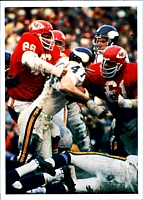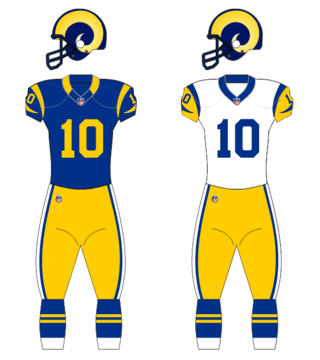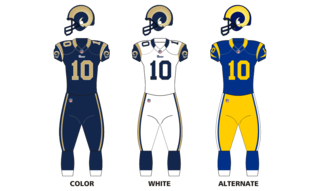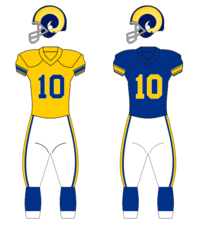
The Los Angeles Dons were an American football team in the newly formed football league the All-America Football Conference (AAFC) from 1946 to 1949, and played their home games in the Los Angeles Memorial Coliseum. The Dons were the first professional football team to play a regular season game in Los Angeles, California, two weeks before the first game of the rival Los Angeles Rams of the National Football League, who had moved from Cleveland.
The 1950 NFL season was the 31st regular season of the National Football League. The merger with the All-America Football Conference (AAFC) expanded the league to 13 teams. Meanwhile, television brought a new era to the game. The Los Angeles Rams became the first NFL team to have all of its games – both home and away – televised. The Washington Redskins became the second team to put their games on TV. Other teams arranged to have selected games televised.
The 1951 NFL season was the 32nd regular season of the National Football League. Prior to the season, Baltimore Colts owner Abraham Watner faced financial difficulties, and thus gave his team and its player contracts back to the league for $50,000. However, many Baltimore fans started to protest the loss of their team. Supporting groups such as its fan club and its marching band remained in operation and worked for the team's revival, which eventually led to a new, more lucrative Baltimore team in 1953 that ultimately carried on the erratic lineage of the last remaining Ohio League member Dayton Triangles.
The 1952 NFL season was the 33rd regular season of the National Football League. Prior to the season, the legacy of the Dayton Triangles, the final remaining Ohio League member and the franchise then known as the New York Yanks owner Ted Collins sold his team back to the NFL. A few days later, a new team was then awarded to an ownership group in Dallas, Texas, after it purchased the assets of the Yanks.
The 1950 NFL Championship Game was the 18th National Football League (NFL) title game, played on Sunday, December 24 at Cleveland Stadium in Cleveland, Ohio.
The 1950 National Football League playoffs took place after the 1950 regular season ended with a tie for first place in both the American and National conferences. The ties forced one-game playoffs to determine who would play in the NFL championship game. It was the only time in the NFL's championship game era that two such tiebreaker playoff games were needed in the same year. The Cleveland Browns and New York Giants tied for first place in the American Conference, while the Chicago Bears and Los Angeles Rams tied for first place in the National Conference. The Browns proceeded to beat the Giants 8–3, and the Rams beat the Bears 24–14 in their playoff game. Cleveland then beat the Rams in the championship game the following week. The home teams won all three games in this postseason.

The 1969 season was the Minnesota Vikings' ninth season in the National Football League (NFL) and their third under head coach Bud Grant. With a 12–2 record, the best in the league, the Vikings won the NFL Central division title, to qualify for the playoffs for the second year in a row. This was the first of three consecutive seasons as the best team in the NFL for the Vikings. They beat the Los Angeles Rams in the Western Conference Championship Game, and the Cleveland Browns in the final NFL Championship Game before the merger with the American Football League. With these wins, the Vikings became the last team to possess the Ed Thorp Memorial Trophy, introduced 35 years earlier in 1934.

The 1984 Los Angeles Rams season was the franchise's 47th season in the National Football League, their 48th overall, and their 39th in the Greater Los Angeles Area. The Rams looked to improve on their 9–7 record from 1983 and make the playoffs for the second consecutive season and 10th in the last 12. They improved on their record by one game, going 10–6, good enough for second place in the NFC West behind the 15–1 San Francisco 49ers. In the playoffs, the Rams lost a low-scoring game to the New York Giants at home, 16–13. During this season, second-year running back Eric Dickerson set the NFL record for most rushing yards in a season, with 2,105 yards.
The 1950 San Francisco 49ers season was the franchise's 1st season in the National Football League and their 5th overall. After playing the previous four years in the All-America Football Conference (AAFC), which folded after the 1949 season, the 49ers, Baltimore Colts, and Cleveland Browns all joined the NFL from the AAFC.
The 1951 San Francisco 49ers season was the franchise's 2nd season in the National Football League and their 6th overall. The team was coming off a 3–9 record in 1950.

The 1983 season was the Los Angeles Raiders' 14th season in the National Football League (NFL), their 24th season overall, and their second season in Los Angeles. The team began by attempting to improve on their 8–1 record from 1982 and went on to win the Super Bowl for the third time in franchise history. Prior to the Los Angeles Rams victory in Super Bowl LVI, the 1983 Raiders were the only NFL team to win the Super Bowl while based in Los Angeles.

The 1994 season was the San Francisco 49ers' 45th in the National Football League (NFL), the 49th overall and their sixth under head coach George Seifert. This season was highlighted by a victory in Super Bowl XXIX. The championship made San Francisco the first team to win five Super Bowls. After losing to the Dallas Cowboys in the previous two conference championship games, the 49ers made significant acquisitions in the 1994 free agent market. This included the signing of two-sport star Deion Sanders and Cowboys linebacker Ken Norton, Jr. Sanders had a major impact on the team's success, winning the NFL Defensive Player of the Year Award and recording six interceptions. The 49ers won their division, the NFC West, for the eighth time in nine seasons.

The 1989 season was the San Francisco 49ers' 40th in the National Football League (NFL), their 44th overall and their 1st season under head coach George Seifert. After going 14–2 in the regular season, the 49ers completed the season with one the most dominant playoff runs of all time, outscoring opponents 126–26, earning their fourth Super Bowl victory and their second consecutive, where they bent over the Broncos, 55–10. They finished with the best record in the NFL for the first time since 1987. Their two losses were by a combined 5 points.

The 1984 San Francisco 49ers season was their 39th season in the National Football League (NFL). The season was highlighted by their second Super Bowl victory. The franchise had its best season ever, with a record of 15 wins and only 1 loss to the Pittsburgh Steelers. Quarterback Joe Montana would be awarded the Super Bowl's Most Valuable Player Award for the second time in his career, joining Bart Starr and Terry Bradshaw as the only two-time Super Bowl MVPs.
The 1953 Detroit Lions season was the franchise's 24th season in the National Football League. The Lions won their second consecutive and third overall National Football League (NFL) championship. In their fourth year under head coach Buddy Parker, the Lions compiled a 10–2 record during the regular season, outscored opponents 271 to 205, finished in first place in the NFL's Western Division, and defeated the Cleveland Browns 17–16 in the NFL Championship Game at Briggs Stadium in Detroit.
The 1952 Detroit Lions season was the franchise's 23rd season in the National Football League. The Lions won their second National Football League (NFL) championship, having won their first championship 17 years earlier in 1935. The team's co-captains were halfback Bob Hoernschemeyer and defensive tackle John Prchlik, and defensive end Jim Doran was selected as the team's most valuable player. In their third year under head coach Buddy Parker, the 1952 Lions compiled a 9–3 record during the regular season, finished in a tie with the Los Angeles Rams for first place in the NFL's National Conference, defeated the Rams in a tiebreaker game, and defeated the Cleveland Browns, 17–7, in the 1952 NFL Championship Game at Municipal Stadium in Cleveland.

The 2016 Los Angeles Rams season was the franchise's 79th season in the National Football League (NFL) and the fifth and final under head coach Jeff Fisher. It was the franchise's 50th season in the Greater Los Angeles Area and the first since 1994. The team returned to Los Angeles after 21 seasons in St. Louis. The Rams decided from 2016 to 2019 to return to wearing white uniforms at home in Los Angeles as a nod to the Fearsome Foursome era. In Week 15 against the Seattle Seahawks, their NFC West divisional rival, the Rams wore white horns on their helmet just for the one game only, a move which would be repeated for the entire following season.

The 2017 San Francisco 49ers season was the franchise's 68th season in the National Football League (NFL) and their 72nd overall. It was also the first season under the head coach/general manager tandem of Kyle Shanahan and John Lynch. After a 0–9 start, they won 6 of their last 7 games and finished the season 6–10, improving from their last two season records. Despite this, the 49ers were eliminated from playoff contention in Week 12.

The 2019 season was the Los Angeles Rams' 82nd in the National Football League (NFL), their 83rd overall, their 53rd in the Greater Los Angeles Area and their third under head coach Sean McVay. It also marked the Rams' final season playing their home games at the Los Angeles Memorial Coliseum, as the team moved into SoFi Stadium in Inglewood beginning with the 2020 season alongside the Los Angeles Chargers. They entered the season as the defending NFC champions looking to bounce back after their Super Bowl LIII loss to the New England Patriots.









